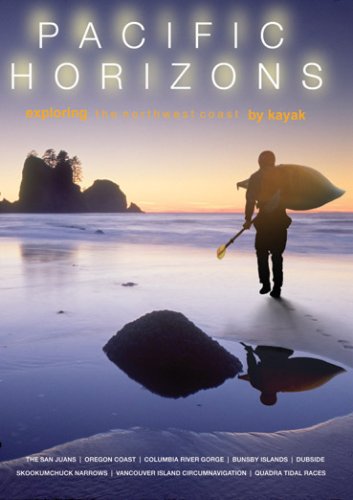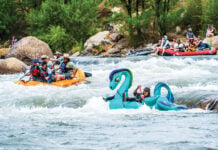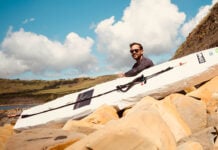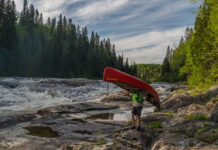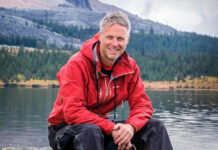In celebration of the 10th anniversary of the Reel Paddling Film Festival, we checked back with a few filmmakers whose films we’ve featured over the past ten years. You can find more stories on past filmmakers in the pages of our Early Summer issue to catch up with them and find out what they’ve been up to since their films embarked on our annual world tour.
 Pacific Horizons
Pacific Horizons
Bryan Smith (Director)
Winner of the Best Sea Kayaking Film award at the Paddling Film Festival in 2008, this film is a celebration of the Pacific Northwest as the ultimate soul food for sea kayakers of all stripes. From surfing with rough water regulars to kayaking with orcas and rolling with “commando kayaker” Dubside, Bryan Smith establishes himself as a skilled cinematographer as he delves into the diverse pleasures that make this region a paddling paradise. 60 minutes, 2007; reelwaterproductions.com
All it takes to kick off your dream career is a chance encounter or conversation with the right people, says Bryan Smith. That, and a pile of passion and hard work.
Smith should know, the documentary filmmaker and owner of Reel Water Productions has emerged from humble beginnings as an indie activist, to adventure cinematography’s go-to guy for the trickiest shots in the toughest locations.
Paddling the whitewater rivers of the Pacific Northwest every weekend, the Michigan transplant bought a cheap camera to document his adventures. When a proposed hydro project was green lighted for his beloved Ashlu River, “I didn’t know what else to do other than pick up the camera and start filming,” recalls Smith.
The resulting film, 49 Megawatts, went viral in British Columbia and became a showpiece for communities fighting their own run-of-river projects. “It showed me that if you do a good job making a film, you inspire people— whether it’s for a love of kayaking or a bigger issue.”
That was 2007. The following year, Smith sought sponsorship from Kokatat and P&H Sea Kayaks, bought a better camera and turned his lens on another passion: sea kayaking. Pacific Horizons featured the Pacific Northwest’s top kayaking ambassadors—including Smith’s own paddling mentors, Shawna Franklin and Leon Sommé—as well as the superb cinematography that was Smith’s nascent specialty. Sea kayaking had never been shot like this before and the film’s success led to an Atlantic follow-up, Eastern Horizons, in 2009.
Many of the locales popularized by the Horizons films—especially tidal features like Skookumchuck, Okisollo and the Bay of Fundy—have become staple destinations for rough water paddlers.
“It’s crazy—no one took sea kayaks to Skooks before,” recalls Smith. “That’s the long-term takeaway: watching those areas that we were the first to really document and seeing that popularity spin off into the greater paddling community, the people watching the films.”
“Horizons showed me that adventure filmmaking is this amazing tool where I not only get to make cool films, I get to dig deeply into places that people dream of going, and I actually get paid to do it.”
Whatever affect Horizons had on the sport of sea kayaking, its influence on Smith’s life and career was even more profound. “Horizons showed me that adventure filmmaking is this amazing tool where I not only get to make cool films, I get to dig deeply into places that people dream of going and I actually get paid to do it,” he says. “Those films inspired me to think even bigger.”
The following year, Smith collaborated with master storyteller Fitz Cahall on The Season, a hugely successful web-TV series that followed five athletes as they progressed through the challenges of their respective seasons. The show’s pioneering format propelled it through 46 episodes spanning two years and more than two million downloads, bringing Smith recognition outside paddling circles.
Surrounded by a growing team and driven by a superhuman work ethic, Smith has since shot nearly every adventure sport under the sun.
“I had this lifelong dream when I started making films that I would someday work for National Geographic,” he remembers, “so I just pounded the pavement long and hard enough that I finally opened the door there.”
That led to work on reality-based television series like Alaska Wing Men and Monster Fish, and the highly acclaimed documentary The Man Who Can Fly with free climber and BASE jumper Dean Potter. But it also led to a lack of creative control.
“They were bringing projects to me, I wasn’t bringing projects to them,” Smith explains.
More recently, he’s been working extensively with Red Bull Media House. Feature documentaries for Red Bull TV like Frozen Titans, an ice climbing film that entailed harrowing -30°C shoots, and Smith’s most recent project— documenting an epic trans-Rockies paragliding flight with athletes Will Gadd and Gavin McClurg—are the brainchildren of Smith and his crew.
Smith admits that going pedal to the metal on high profile, big budget shoots makes it harder to carve out time for passion projects. Still, he’s managed to squeeze a few in over the years: whitewater exploration in Kamchatka in 2010 and filming Sea Kayak Rescues with Franklin and Sommé. In 2013, The Joy of Air, a short film that captures the unbridled pleasure of catching air, featured appearances by Smith and partner Lise-Anne Beyries’ young son, Nelson, alongside eight-year-old mountain biking phenom, Jackson Goldstone.
And Smith isn’t finished with sea kayaking. “One thing I’ve never done with sea kayaking is a two- or three-month expedition,” he says, hinting at a project brewing for summer 2016. He isn’t divulging details, but he says he’d like the story to captivate a mainstream documentary audience, rarified waters in the realm of paddling docs.
There’s no doubt it will be a very different film than Pacific Horizons. In part, that’s because of the vast evolution in camera equipment over the past decade.
“We pretty much shoot exclusively now on RED Dragons—these are the same cameras that Peter Jackson just shot The Hobbit on,” marvels Smith. “This camera system costs $40,000. Back when I shot Horizons, if I wanted to shoot on the cameras that Hollywood was using, they were a quarter- to a half-million dollars. The tools have become democratized to a point where creativity reigns.”
Just as significant, however, is that Smith’s creative vision has become as finely honed a lens as his camera’s, earning him the trust of some of the deepest pockets in adventure filmmaking.
“I had a moment last summer, where I was in Vancouver rigging a helicopter with a $750,000, gyro-stabilized camera system, and I almost broke down,” Smith recalls. “I couldn’t believe that in just seven years, I had gone from a crappy little camera that I bought at Walmart, to the most sophisticated camera system in the world.”
Unlike Hollywood’s A-listers, the success hasn’t gone to Smith’s head. He owes it all, he says, to the mentors and early sponsors he found through paddling. “They started me on a path that totally changed my life.”
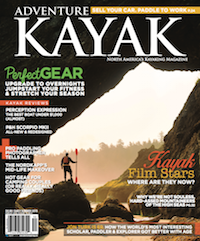
Subscribe to Paddling Magazine and get 25 years of digital magazine archives including our legacy titles: Rapid, Adventure Kayak and Canoeroots.



